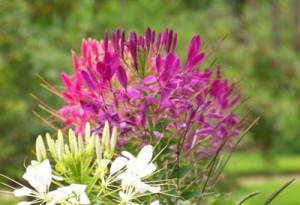The Spider Plants Cleome and Chlorophytum
Common names can be used for more than one species.

Cleome hassleriana
If you are looking to grow something a little unusual, it is worth having a go at growing Cleome, sometimes known as the ‘Spider Plant’
The genus Cleome encompasses about 170 herbaceous annual or perennial plants. A common garden variety is Cleome hassleriana.
- Cleome’s can grow quite tall, upto 4 feet in some cases. It has attractive spider shaped leaves and after flowering leaves seed pots streched out horizontally. The flowering season can last for 2-3 months.
- In the beginning they are susceptible to the usual pests like slugs and snails and will need protection. Once established Cleomes can reproduce at a quick rate.
- They may need staking as they become susceptible to windy conditions.
Cleome spinosa is good for dry conditions.
Houseplant called Spider Plant
Chlorophytum comosum is often called the spider plant. It has interesting, frondy, generally bicoloured leaves and they are the main reason for growing this plant. Small white flowers are found on mature plants.
Plantlets form on the end of arching stems and these spidery stems make propagation simple.
2 thoughts on “The Spider Plants Cleome and Chlorophytum”
does a single cleome plant polinate itself or are the plant strickly male and female?
how do you make it so a single cleome wont pollinate itself in order to cross pollinate?
Comments are closed.